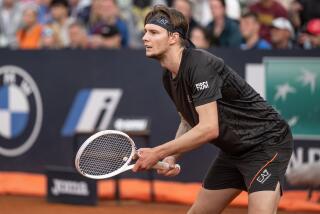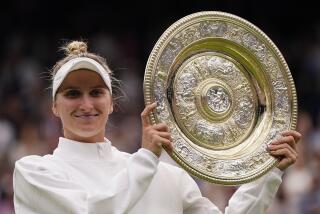Soviet Union Starts to Come On Strong in Tennis With Top Young Players
- Share via
In San Francisco recently, Larisa Savchenko of the Soviet Union defeated Mary Joe Fernandez, Hana Mandlikova and Gabriela Sabatini before losing in the final of the Virginia Slims of California tennis championships to Martina Navratilova.
Last year, Natalia Zvereva, also of the Soviet Union, won the junior titles at Wimbledon and the French and U.S. opens, and got to the final of the Slims event in Chicago, defeating Claudia Kohde-Kilsch and Barbara Potter.
So maybe this glasnost thing really means “wicked forehand.”
In the last decade, Soviet tennis has grown from a caravan of one--Olga Morozova, now the coach for women’s tennis in the Soviet Union--to male and female up-and-comers. Four players were at the Virginia Slims of Washington tournament, and two more were at a Slims event in Oklahoma.
“They’re all pretty fine all-court players,” said Potter, who went to two tiebreakers last year before beating Savchenko to win the Virginia Slims of Kansas. “They look to a bright future, I think. Evidently, there are a lot of young players prowling at the gates.”
Andrei Chesnokov is the best hope among male players, but the Soviet women have depth. Zvereva, 16 years old and 15th in the world, is top-ranked in the Soviet Union, and already has qualified for its Olympic team.
Savchenko, in the top 50, also has qualified, and the final spot probably will go to either Natalia Bykova or Leila Meskhi.
“Our (Soviet Tennis Federation) is trying hard,” said Morozova. “Historically, tennis is not a very big sport. But because of a lot of tennis on TV, and because of our results, they are coming around.”
“They’re new to the tour,” said Helena Sukova of Czechoslovakia, “but they’re not new to me because I played them so much in the juniors. You guys are finding out that they have good players. We knew that before.”
When Morozova began playing in the late 1960s, things were different.
“I had the same experience,” she said. “(But) when I first came to the U.S., we didn’t have such a good relationship. It was good, but it was just the start of it. It was difficult to break the thinking of American people about Russian people.”
Morozova, who was a finalist at the U.S. Open in 1976, and Wimbledon and the French Open in 1974, was the last Soviet woman to win a pro tournament, more than 13 years ago. When she retired to begin a family, there was no Soviet player or prospect to be found.
Asked to help develop the fledging Soviet tennis program, Morozova has become the mentor for the Soviet women, none of whom is older than 21. Along with Zvereva’s father, Marat, Morozova has improved the techniques of the Soviet players.
“She is a great helper for all of us,” Zvereva said. “She stays with us on the tour. She’s a great person. I like to speak with her after the matches, about strategy. But don’t forget my father. He’s my first coach.”
The Soviet players are still considered amateur on the U.S. tour by the Soviet Federation, because the Soviets do not consider any of their athletes professionals. For that reason, the individual players cannot accept prize money, and most of the winnings are returned to the federation to help Soviet junior players, Zvereva said.
And the sport, with the success of Chesnokov--he beat Mats Wilander in the third round of the 1986 French Open--and the women, has taken off, Morozova said. There are between 24 and 36 players competing to get on the national team; overall, some 80,000 people now play in the Soviet Union.
There are still problems in dealing with the language here (Zvereva is the only one of the four in Washington who speaks English regularly) and in finding outdoor facilities in the Soviet Union. Also, the players are relatively inexperienced in dealing with other pros.
“If you don’t prepare them, there’s no reason to bring them over,” Morozova said.
When the players first arrived, Morozova said, there were problems. Now, they are adjusting.
“Now, they’re in the family of tennis players,” she said. “They know the routine. They know the tournaments, they know the press conferences. They would like to be able to see more of the cities they’re in, but they know the first reason they are here is to play tennis.”
More to Read
Go beyond the scoreboard
Get the latest on L.A.'s teams in the daily Sports Report newsletter.
You may occasionally receive promotional content from the Los Angeles Times.










